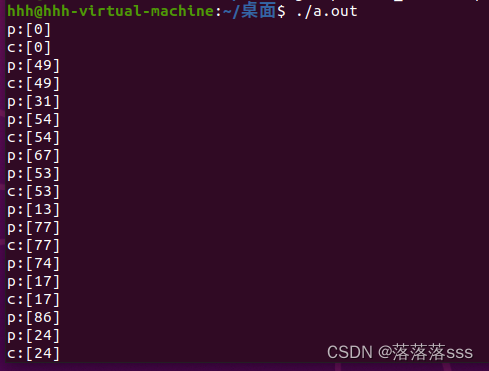条件变量
条件变量本身不是锁,但是它可以造成线程阻塞。通常于互斥锁配合使用。给多线程提供一个会和的场合。
- 使用互斥量保护共享数据
- 使用条件变量可以造成线程阻塞,等待某个条件的发生,当条件满足的时候解除阻塞。
条件变量的两个动作:
- 条件不满足,阻塞线程
- 条件满足,通知阻塞的线程解除阻塞
相关函数:
pthread_cond_t cond 定义一个cond条件变量
int pthread_cond_init(pthread_cond_t *restrict cond,
const pthread_condattr_t *restrict attr);
函数描述:初始化条件变量;
cond 条件变量 attr 条件变量属性,设NULL
函数返回值:成功返回0,失败返回错误号
int pthread_cond_destroy(pthread_cond_t *cond);
函数描述:销毁一个条件变量
int pthread_cond_wait(pthread_cond_t *restrict cond,
pthread_mutex_t *restrict mutex);
函数描述:条件不满足,引起线程阻塞并解锁
条件满足,解除条件阻塞,并加锁
函数参数:cond->条件变量 mutex->互斥锁
int pthread_cond_signal(pthread_cond_t *cond);
函数描述:唤醒至少一个阻塞在该条件变量(cond)上的线程
函数参数:条件变量
函数返回值:成功返回0,失败返回错误号
生产者与消费者模型:
#include<stdio.h>
#include<string.h>
#include<stdlib.h>
#include<sys/types.h>
#include<unistd.h>
#include<pthread.h>
//定义一个链表
typedef struct node
{int data;struct node* next;
}node;
//定义一个头节点
node *phead;
//定义一个互斥锁变量
pthread_mutex_t mutex;
//定义一个条件变量
pthread_cond_t cond;
void *producer(void *arg)
{srand(time(NULL));while(1){
//生成一个新的节点node *pNode=NULL;pNode=(node*)malloc(sizeof(node));if(pNode==NULL){printf("malloc error");exit(-1);}
//加锁pthread_mutex_lock(&mutex);pNode->data=rand()%100;//随机生成数printf("p:[%d]\n",pNode->data);
//头插法:pNode->next=phead;phead=pNode;
//解锁pthread_mutex_unlock(&mutex);
//唤醒至少一个线程pthread_cond_signal(&cond);sleep(1);//防止生成过快,导致内存不足}
}
void *consumer(void *arg)
{while(1){pthread_mutex_lock(&mutex);//加锁if(phead==NULL){
//如果头节点为空,那么阻塞并解锁
//如果头节点不为空,接收到pthread_cond_signal的唤醒,解除阻塞并加锁pthread_cond_wait(&cond,&mutex);}node*pNode=phead;printf("c:[%d]\n",pNode->data);
//头节点移动phead=phead->next;
//释放当前节点free(pNode);pNode=NULL;
//解锁pthread_mutex_unlock(&mutex);sleep(2);}
}
int main()
{pthread_mutex_init(&mutex,NULL);//初始化互斥锁pthread_cond_init(&cond,NULL);//初始化条件变量pthread_t thread1;pthread_t thread2;int ret=pthread_create(&thread1,NULL,producer,NULL);if(ret!=0){printf("pthread_create1 error:[%s]\n",strerror(ret));return -1;}ret=pthread_create(&thread2,NULL,consumer,NULL);if(ret!=0){printf("pthread_create2 error:[%s]\n",strerror(ret));return -1;}
//阻塞等待线程结束pthread_join(thread1,NULL);pthread_join(thread2,NULL);
//销毁pthread_mutex_destroy(&mutex);pthread_cond_destroy(&cond);return 0;
}
多线程core掉的情况:
假如只有一个生产者生产了一个节点,此时会调用pthread_cond_signal通知消费者线程,此时若有多个消费者被唤醒了,则最终只有一个消费者获得锁,然后进行消费,此时会将head置为NULL,然后其他被唤醒的消费者线程会有一个获得锁,然后读取的head的内容会core掉。
#include<stdio.h>
#include<string.h>
#include<stdlib.h>
#include<sys/types.h>
#include<unistd.h>
#include<pthread.h>
typedef struct node
{int data;struct node* next;
}node;
node *phead;
pthread_mutex_t mutex;
pthread_cond_t cond;
void *producer(void *arg)
{srand(time(NULL));while(1){node *pNode=NULL;pNode=(node*)malloc(sizeof(node));if(pNode==NULL){printf("malloc error");exit(-1);}pthread_mutex_lock(&mutex);pNode->data=rand()%100;printf("p:[%d]\n",pNode->data);pNode->next=phead;phead=pNode;pthread_mutex_unlock(&mutex);pthread_cond_signal(&cond);sleep(1);}
}
void *consumer(void *arg)
{int n;while(1){n=*(int *)arg;pthread_mutex_lock(&mutex);if(phead==NULL){pthread_cond_wait(&cond,&mutex);}if(phead==NULL){pthread_mutex_unlock(&mutex);//先解锁,因为pthread_cond_wait会加一个锁continue;}node*pNode=phead;printf("c[%d]:[%d]\n",n,pNode->data);phead=phead->next;free(pNode);pNode=NULL;pthread_mutex_unlock(&mutex);sleep(1);}
}
int main()
{int i=0;int arr[5];pthread_mutex_init(&mutex,NULL);pthread_cond_init(&cond,NULL);pthread_t thread1;pthread_t thread2;int ret=pthread_create(&thread1,NULL,producer,NULL);if(ret!=0){printf("pthread_create1 error:[%s]\n",strerror(ret));return -1;}for(;i<5;i++)//创建5个消费者子线程{arr[i]=i;ret=pthread_create(&thread2,NULL,consumer,&arr[i]);if(ret!=0){printf("pthread_create2 error:[%s]\n",strerror(ret));return -1;}}pthread_join(thread1,NULL);pthread_join(thread2,NULL);pthread_mutex_destroy(&mutex);pthread_cond_destroy(&cond);return 0;
}
)











)






